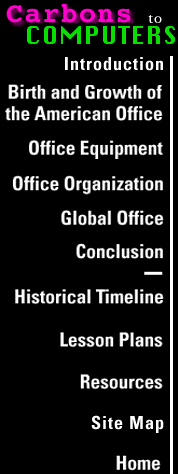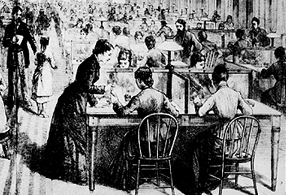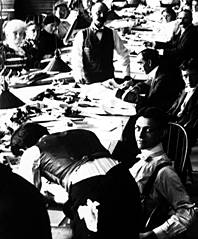
Railroads and the Birth of the Modern Office
If the small office of a textile merchant would be administratively overwhelmed by expanding trade, imagine the problems for the new railroad companies. For the first time in American business, the financial investment in an enterprise was too large for one owner or even for a small group of owners. Hardly a mom-and-pop company, the railroad was a multimillion-dollar corporation of stockholders and bankers that had to supervise hundreds of employees and its investment.

Railroads employed conductors, ticket sellers, engineers, construction workers, accountants, clerks, and payroll officers. Their employees were distributed across the country, serving the entire transportation network and offices along the way. Administering this corporation profitably meant developing not only an entirely new system of organization but also a vast interoffice communication system.
The stockholders and board members could not run the railroad's
day-to-day operations. Instead, full-time employees were needed to make
decisions and supervise the monies and staff necessary to keep the corporation
profitable. The railroad needed men who were willing to and capable of acting
like owners for the owners without any chance of ever being owners.
The railroad needed managers just as much as it needed rails and
boxcars and a  reliable and safe transport system to
sell. Coordinating the movement of people and goods, maintaining roundhouses,
rail line, and stations, and making a profit were now the manager's job.
reliable and safe transport system to
sell. Coordinating the movement of people and goods, maintaining roundhouses,
rail line, and stations, and making a profit were now the manager's job.
As demand for the railroads' services increased, more and more managerial employees were hired and a hierarchy of managers took its place on the corporate organizational chart. Owners and board members soon had little say in the operation of the railroads. They may have set fiscal policy, but their employees in offices throughout the country put the policy into practice and ran their company. By 1840 or 1850, management was a permanent part of the railroads' organization, and managers began to think of railroading as a lifelong career with chances for advancement. This was the beginning of modern business and its offices.
Mid-level managers oversaw central offices, supervising bookkeepers and clerks. These offices kept in close contact with each other by telegraph and daily mail carried by the trains. The mid-level managers reported to top managers, who reported to the board of directors.
By the 1880s, this organization and hierarchy would be duplicated by Western Union, the banking industry, and insurance companies. These businesses, like the railroads, were big, complex, geographically dispersed, and responsible for huge amounts of money not owned by one person or family. Their success was replicated by large manufacturers, importers, and chain stores. The railroads' administrative organizations had successfully proved that they could increase productivity, volume, and profits. Every other large business followed their example.
By the turn of the century, business administration was a profession. Harvard, Wharton, and the University of Chicago were already offering MBAs (master's degrees in business administration).